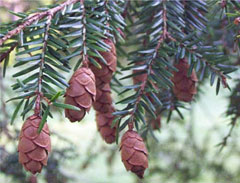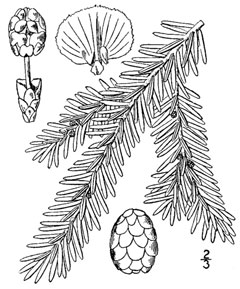 |
|
ttp://de.wikipedia.org/wiki/Benutzer:Nasenbär |
 |
|
Translate this page:
Summary
Bloom Color: Green, Yellow. Main Bloom Time: Early spring, Late spring, Mid spring. Form: Pyramidal.
Physical Characteristics

 Tsuga canadensis is an evergreen Tree growing to 20 m (65ft) by 8 m (26ft) at a medium rate.
Tsuga canadensis is an evergreen Tree growing to 20 m (65ft) by 8 m (26ft) at a medium rate.
See above for USDA hardiness. It is hardy to UK zone 4. It is in leaf all year, in flower in May, and the seeds ripen from November to February. The species is monoecious (individual flowers are either male or female, but both sexes can be found on the same plant) and is pollinated by Wind.
Suitable for: light (sandy), medium (loamy) and heavy (clay) soils and prefers well-drained soil. Suitable pH: mildly acid, neutral and basic (mildly alkaline) soils and can grow in very acid soils.
It can grow in full shade (deep woodland) semi-shade (light woodland) or no shade. It prefers moist soil.
UK Hardiness Map
US Hardiness Map
Synonyms
Abies americana. A. canadensis. Pinus americana.
Plant Habitats
Woodland Garden Canopy; Ground Cover; Hedge;
Edible Uses
Edible Parts: Inner bark Shoots
Edible Uses: Condiment Tea
Inner bark - raw or cooked[213]. Usually harvested in the spring[2], it can be dried, ground into a powder and then used as a thickening in soups etc or mixed with cereals when making bread[2, 46, 161]. An emergency food, it is only used when all else fails[183]. The leaves and twigs yield 'spruce oil', used commercially to flavour chewing gum, soft drinks, ice cream etc[183]. A herbal tea is made from the young shoot tips[2, 62, 95, 159, 183, 257]. These tips are also an ingredient of 'spruce beer'[183].
References More on Edible Uses
Medicinal Uses
Plants For A Future can not take any responsibility for any adverse effects from the use of plants. Always seek advice from a professional before using a plant medicinally.
Antidiarrhoeal Antipruritic Astringent Diaphoretic Diuretic Dysentery Eczema Skin
Styptic
Canadian hemlock was commonly employed medicinally by several native North American Indian tribes who used it to treat a variety of complaints[257]. It is still sometimes used in modern herbalism where it is valued for its astringent and antiseptic properties. The bark is rich in tannin and is astringent and antiseptic[222, 254]. A decoction is used in the treatment of diarrhoea, colitis, diverticulitis and cystitis[254]. Externally, it is used as a poultice to cleanse and tighten bleeding wounds, as a douche to treat excessive vaginal discharge, thrush and a prolapsed uterus, and as a mouthwash and gargle for gingivitis and sore throats[222, 254]. The poultice has also been applied to the armpits to treat itchiness there[257]. The inner bark is diaphoretic and styptic[21, 213, 257]. An infusion is used in the treatment of colds and abdominal pains[21, 213, 257]. A decoction of the inner bark has been applied externally in the treatment of eczema and other skin conditions[257]. The pulverized inner bark has been applied to cuts and wounds to stop the bleeding[257]. A tea made from the leafy twig tips is used in the treatment of dysentery, kidney ailments, colds and rheumatism[21, 222, 257]. Externally, it is used in steam baths for treating colds, rheumatism and to induce sweating[222]. A decoction of the branches has been boiled down to a syrup or thick paste and used as a poultice on arthritic joints[257]. A poultice of the crushed branch tips has been used to treat infections on an infants navel[257]. Hemlock pitch has been used externally as a counter-irritant in the treatment of rheumatism[213].
References More on Medicinal Uses
The Bookshop: Edible Plant Books
Our Latest books on Perennial Plants For Food Forests and Permaculture Gardens in paperback or digital formats.

Edible Tropical Plants
Food Forest Plants for Hotter Conditions: 250+ Plants For Tropical Food Forests & Permaculture Gardens.
More

Edible Temperate Plants
Plants for Your Food Forest: 500 Plants for Temperate Food Forests & Permaculture Gardens.
More

More Books
PFAF have eight books available in paperback and digital formats. Browse the shop for more information.
Shop Now
Other Uses
Basketry Dye Hedge Hedge Resin Rust Tannin Wood
Yields a resin similar to Abies balsamea, it is gathered by incisions in the trunk or by boiling the wood[46, 61, 64]. A pitch (called hemlock pitch), is obtained by distillation of the young branches[46]. 'Oil of Hemlock' is distilled from the young branches according to another report[82]. The bark contains 8 - 14% tannin[46, 171, 223]. The inner bark is used according to one report[82]. The inner bark has been used in making baskets[257]. A red to brown dye is obtained from the bark[21, 46, 257]. A red dye is obtained from the inner bark according to another report[226]. A little rock dust has been added to act as a mordant when boiling the bark[257]. The boiled bark has been used to make a wash to clean rust off iron and steel, and to prevent further rusting[257]. Tolerant of light trimming, plants can be grown as a hedge[81]. This species does not make a good hedge in Britain[200]. Some cultivars can be grown as a ground cover when planted about 1 metre apart each way[208]. 'Pendula' is slow-growing but makes a very good cover[208]. Wood - coarse-grained, light, soft, not strong, brittle, not durable outdoors[21, 46, 61, 82, 171, 229]. Difficult to work because it splits easily[226]. The wood weighs 26lb per cubic foot[235]. The trees do not self-prune and so the wood contains numerous remarkably hard knots that can quickly dull the blade of an axe[226]. A coarse lumber, it is used occasionally for the outside of buildings[21, 46, 61, 82, 171, 229]. It should be used with caution as a fuel for outdoor fires because it can project embers and burning wood several metres from the fire[226].
Special Uses
Food Forest Ground cover Hedge Hedge Scented Plants
References More on Other Uses
Cultivation details
Landscape Uses:Firewood, Hedge, Aggressive surface roots possible, Massing, Screen, Specimen, Woodland garden. An easily grown plant, it thrives best when growing in a deep well-drained soil in the western parts of Britain where it appreciates the higher rainfall[11]. However, it succeeds in most soils and positions, being especially good on acidic sandy soils[81] but also tolerating some lime[11] so long as there is plenty of humus in the soil[208]. Plants are very shade tolerant when young, but need more sunlight as they grow older[81, 200]. Plants are thin and poor when grown in dry or exposed places[200]. A slow-growing but long-lived species in the wild, with specimens nearly 1000 years old recorded[229]. It is occasionally planted as a timber tree in Germany[50]. It is very slow growing in cultivation for the first few years, it then grows more rapidly with annual shoots up to 60cm long. This rate of growth soon slows as the tree loses apical dominance and it becomes slow growing again[185]. Seed production commences around the age of 20 - 40 years, with good crops produced every 3 - 4 years[229]. The crushed foliage has a sweet lemony scent[185]. Another report says that it emits the unpleasant smell of hemlock[245]. Many named forms have been selected for their ornamental value[185]. Almost all of them are dwarf forms[200]. Plants in this genus are notably resistant to honey fungus[200]. Special Features:Attracts birds, North American native, Inconspicuous flowers or blooms.
References Carbon Farming Information and Carbon Sequestration Information
Temperature Converter
Type a value in the Celsius field to convert the value to Fahrenheit:
Fahrenheit:
The PFAF Bookshop
Plants For A Future have a number of books available in paperback and digital form. Book titles include Edible Plants, Edible Perennials, Edible Trees,Edible Shrubs, Woodland Gardening, and Temperate Food Forest Plants. Our new book is Food Forest Plants For Hotter Conditions (Tropical and Sub-Tropical).
Shop Now
Plant Propagation
Seed - it germinates better if given a short cold stratification[80, 113] and so is best sown in a cold frame in autumn to late winter. It can also be sown in early spring, though it might not germinate until after the next winter. If there is sufficient seed, an outdoor sowing can be made in spring[78]. Pot-grown seedlings are best potted up into individual pots once they are large enough to handle - grow them on in a cold frame and plant them out in early summer of the following year. Trees transplant well when they are up to 80cm tall, but they are best put in their final positions when they are about 30 - 45 cm or less tall, this is usually when they are about 5 - 8 years old[200]. Larger trees will check badly and hardly put on any growth for several years. This also badly affects root development and wind resistance[200].
Other Names
If available other names are mentioned here
Native Range
NORTHERN AMERICA: Canada (Québec (south), Nova Scotia, Ontario (southeast), Prince Edward Island, New Brunswick), United States (Indiana (south), Maine, Massachusetts, Michigan, New Hampshire, New Jersey, New York, Ohio, Pennsylvania, Rhode Island, Vermont, West Virginia, Connecticut, Minnesota (east), Wisconsin, Alabama (north), Delaware, Georgia (north), Kentucky, Maryland, North Carolina, South Carolina, Virginia, Tennessee)
Weed Potential
Right plant wrong place. We are currently updating this section.
Please note that a plant may be invasive in one area but may not in your area so it's worth checking.
Conservation Status
IUCN Red List of Threatened Plants Status :

Growth: S = slow M = medium F = fast. Soil: L = light (sandy) M = medium H = heavy (clay). pH: A = acid N = neutral B = basic (alkaline). Shade: F = full shade S = semi-shade N = no shade. Moisture: D = dry M = Moist We = wet Wa = water.
Now available:
Food Forest Plants for Mediterranean Conditions
350+ Perennial Plants For Mediterranean and Drier Food Forests and Permaculture Gardens.
[Paperback and eBook]
This is the third in Plants For A Future's series of plant guides for food forests tailored to
specific climate zones. Following volumes on temperate and tropical ecosystems, this book focuses
on species suited to Mediterranean conditions—regions with hot, dry summers and cool, wet winters,
often facing the added challenge of climate change.
Read More
Expert comment
Author
(L.)Carrière.
Botanical References
1182200
Links / References
For a list of references used on this page please go here
Readers comment
| Add a comment |
|
If you have important information about this plant that may help other users please add a comment or link below. Only comments or links that are felt to be directly relevant to a plant will be included. If you think a comment/link or information contained on this page is inaccurate or misleading we would welcome your feedback at [email protected]. If you have questions about a plant please use the Forum on this website as we do not have the resources to answer questions ourselves.
* Please note: the comments by website users are not necessarily those held by PFAF and may give misleading or inaccurate information.
To leave a comment please Register or login here All comments need to be approved so will not appear immediately.
|
Subject : Tsuga canadensis
|
|
|
|